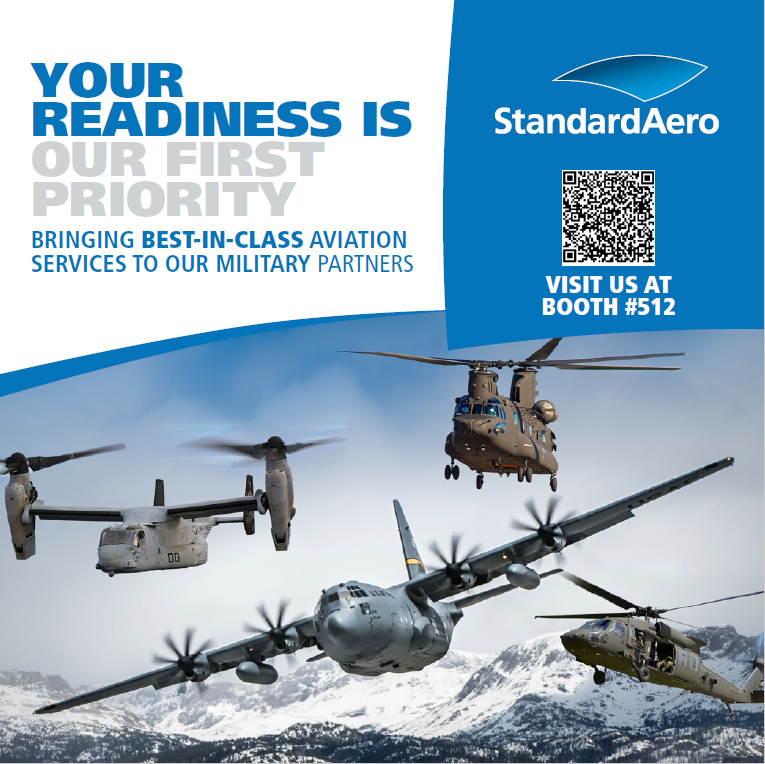Looking Back, July 2025
By Mark Albertson
Part I: Army Aviation and its, Magna Carta
If we are successful, the air mobile concept will be a dynamic advance for the Army. If we are not, we will go back to flying Piper Cubs, if we have that much left, and the Army and the country as a whole will lose one of those things that . . . can mean the difference between victory and defeat in future land combat. Colonel George P. Seneff, Jr., 11th Air Assault Division (Test).[1]
* * * * *
“In 1949, Pete Quesada predicted that if the Air Force did not meet the Army’s needs for Close Air Support within five years, the Army would be able to justify the creation of its own air force. By 1954, the Army had, in fact, taken steps that would result in the creation of its own air force. Concurrent with the decrease in status of close air support in the new U.S.A.F., the Army began the early development of what would later become Army Aviation.”[2]
With the 1947 National Security Act, crafted to fashion the post-1945 American armed forces for the strategic competition with the Soviet Union, the divorce between the strategic airmen and ground forces was finalized by government fiat; based, of course, on the acceptance of a reality that, by this time, and was at last understood, that the growing sophistication of modern industrialization was spurring invention, innovation and specialization of tasks, had rendered airpower—particularly of the strategic variety—to be a semblance of warfare beyond the purview of ground officers. Hence the United States Air Force.
At the same time, the political jealousies of the Bomber Mafia motivated them to not only preserve their Magna Carta of freedom, but to engage with all dispatch into the political arena so as to assert primacy in an era of reduced military budgets. And the strategic airmen were not without cards to play. The strategic bomber had played an important role in winning the last industrialized global conflict.[3] And new technological innovations would produce new airborne conveyances of strategic airpower of even greater superior types. Plus the Air Force had the Bomb. No longer would 500 to 1,000 plane raids be delivering the conventional ordnance required; just a single or several bombers dropping atomic ordnance would have assured the primacy of America’s capability to respond to strategic threats. Yet, what about the tactical responsibilities of the Air Force? Again, Pete Quesada:
“Quesada, however, saw the establishment of T.A.C. (Tactical Air Command) as illusory. In the reduced budgets and promotion opportunities of the early days of the Cold War, the Air Force’s major bomber command, S.A.C. (Strategic Air Command) received priority, including 65 percent of the first Air Force budget. In terms of operational forces, the organizational structure greatly favored the big bombers. Quesada disputed the ration of forces in the new service as not reflecting wartime realities. After the final round of demobilization, S.A.C contained 75 percent of the force compared to T.A.C’s 25 percent.”[4]
Quesada’s observations were correct and, mirrored in his memoirs by General Matthew Ridgway, “. . . that is the Air Force did not provide the Army with the resources it needed for C.A.S., the Army ‘eventually will have to develop them ourselves.’”[5]
The Korean conflict showcased the need for the tactical use of airpower in the post-1945 era. And the Army, having employed the helicopter to fulfill some of its tactical requirements proceeded after July 27, 1953, to expound on the advantages afforded by rotary wing aircraft. Hence Hutton, Vanderpool, Gavin, Howze, . . . In other words, yes, the Army was going to develop further, those tactical aerial assets necessary to fulfill that raison d’etre of the Army . . . to prosecute America’s ground wars.
The Army was not alone in the quest for the aerial mobility of its rifle totters. Prior to and following the Korean War, the Marine Corps recognized the advantages of air transported troops, and mainly by helicopter. And for the Corps, that meant transforming amphibious warfare in the Age of the Bomb. This led to the conversion of light carriers into assault ships so as to accommodate Marine Corps amphibious warfare; that is, getting marines ashore, supplying them once ashore and, of course, shuttling them to and from battle areas. Light carrier conversions were the preliminary to the LPH or Landing Platform Helicopter, AKA Landing Ship Personnel Helicopter. The vessels were built from the keel up as amphibious assault vessels.
Landing Force Bulletin 17, the Marine Corps doctrine of amphibious warfare saw seaborne as well as airborne landings of leathernecks on a hostile shore. And the primary medium for delivering marines was the helicopter. Hence the necessity of the LPH.
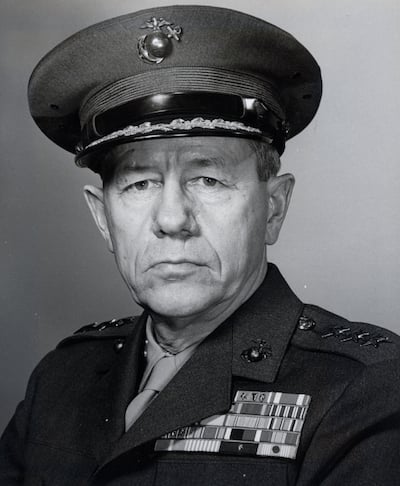
Marine Corps General Robert E. Hogaboom, Jr., who chaired the Marine Corps ‘Hogaboom Board,’ June-December 1956, to develop the Fleet Marine Force Concept or Vertical Assault Concept, together with the development of the helicopter.
From June to December 1956, a concerted group of officers was organized to study this Fleet Marine Force Concept—the Hogaboom Board, chaired by Major General Robert E. Hogaboom, U.S.M.C. Comprised of a single general officer and 13 colonels, “This group was a mixture of naval aviators and ground officers of all specialties. Any specialty not included on the board was furnished by interviews with numerous recognized experts and others selected for their combat experience. Many of the board members firmly believed that the role of the Marine Corps should not duplicate that of the Army or vice versa and the Marine division be capable of an all-helicopter assault.”[6]
The Hogaboom Board recommended changes conducive to the readiness of the Marine Corps division. The division itself would be reduced in size from 21,000 to 19,000. Air assaults were to be fully transportable by helicopter, with heavy equipment and weapons deleted from the new division structure. “Major changes included increased command and staff personnel, administrative and supply personnel transferred from regimental level to division, the weapons company replaced by a fourth rifle company in each infantry battalion, the tank battalion was transferred to force troops, and the reconnaissance company was increased to battalion strength.”[7]
An alteration of note was the elimination of armor from the new Marine division. Armed helicopters and air-to-surface missiles would replace tanks, seen as they were as emblematic of modern-based mobility free of earth-bound impediments. In addition, 106 mm recoiless rifles were viewed as being effective against enemy armor.
The 155 mm howitzer was to be eliminated from the division artillery regiment, replaced by the 105 mm howitzer. Again, the mobility inherent in an air transportable division saw aerial assets such as the armed helicopter as more of a replacement for such heavy equipment as tanks and large caliber artillery. When required, the force division equipped with armor and heavy artillery could employ same.
The Marine air wing maintained its personnel level, some 8,000 to 10,000. It featured all manner of aerial responsibilities: medium helicopter, light helicopter, all-weather aviation, fixed wing transportation, attack aviation and fighters. Besides standard duties normally associated with the aforementioned capabilities, there now had to be added another, protection for the assault force.
During the mid-1950s, the Marine Corps helicopter capabilities rested on several types: utility, reconnaissance and heavy lift. “Included in each air wing were two light helicopter transport squadrons, one composite reconnaissance squadron and one medium helicopter squadron with a total of 87 helicopters.
“The air wing had the capability to move in one lift about 876 troops with full equipment and within a 100-mile operating radius. The challenge of supporting both fixed wing and rotary wing operations from the ground was partially resolved by development of a bulk-fuel handling system that was helicopter transportable and offered a supply of 300,000 gallons capacity to the landing force.”[8]
Marine Corps Commandant, General Randolph McCall Pate, approved the recommendations of the Hogaboom Board, with the application of minor changes. The Corps was to begin acting on the changes in early 1957, which were to be fully implemented in 1958. By the end of 1961, the Fleet Marine Force was able to employ a number of air assault operations from the battalion level from LPH ships, providing the Marine Corps and the Navy with a powerful capability to enforce the Nation’s interests.
* * * * *
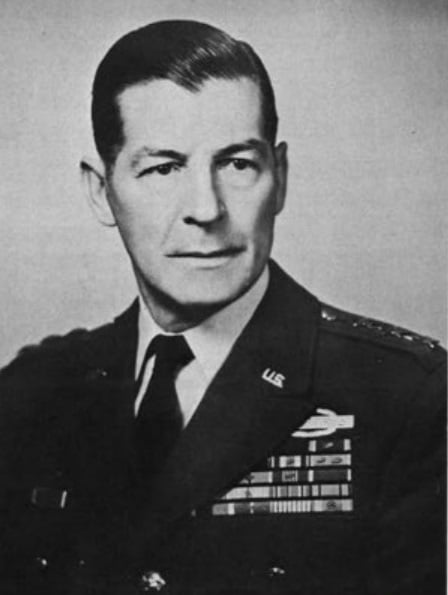
General Gordon B. Rogers, deputy commander of the Continental Army Command, was chosen as the chairman of the 1960 Aircraft Requirements Review Board or Rogers Board. Task was to enlist industry to forward offers for aircraft for developing an air transportable army.
January 15, 1960, Army Chief of Staff, General Lyman L. Lemnitzer, chose the deputy commanding general of the Continental Army Command, Lieutenant General Gordon B. Rogers, to be chairman of the Army Aircraft Requirements Board, AKA the Rogers Board. Aim was to consider industry offers for the Aircraft Development Plan. This included a recommendation for the increased use of the helicopter. But at the same time the Board urged the expansion of the Army’s air lift capability, it did not readily broach the topic of airmobility as an agenda for acceptance by the Army.
The object of the Rogers Board was to refresh the Army’s stable of aircraft in preparation for an air-transportable ground force. Aircraft current with 1960 such as the Cessna L-19 or Bird Dog, Bell H-13 and the Hiller H-23, were to be sent to pasture in lieu of fixed wing and helicopters conducive to forging the air transportability of ground forces by 1970. Followed in the early 1970s by rotary wing and short takeoff types able to replace the CH-47 Chinook and CV-2 Caribou in that never-ending evolution of invention in effecting the modern soldier’s ability to carry out the mission on the battlefield.
By February 1, 1960, forty-five companies forwarded 119 aircraft designs. These designs were weighed and measured by two entities: The Office of the Chief of Transportation for a technical review, February 1-15; in turn, followed by the Office of the Chief of Research and Development, for an operational review. Following these evaluations the Rogers Board convened at Fort Monroe, February 29 through March 6, to evaluate the Army Aircraft Development Plan.
The members of the Army Aircraft Requirements Review Board: Chairman, Lieutenant General Gordon B. Rogers, the Deputy Commanding General of the Continental Army. Other board members: Major General Robert J. Wood, Major General Hamilton H. Howze, Major General Thomas F. Van Natta, Major General Alva R. Fitch, Major General Richard D. Meyer, Major General Ernest F. Easterbrook, Brigadier General William M. Thames, Jr., and Brigadier General Clifton von Kann.
Attached, too, was Colonel Robert R. Williams, chief of the Airmobility Division, Office of Chief of Research and Development. A man who helped to organize the Rogers Board, but accorded without voting power. Another board member, minus a vote was Deputy Director of Army Aviation, John J. Tolson.[9]
Recommendations put forth by the Rogers Board concerned three types of aircraft: Transport, surveillance and observation/reconnaissance. As intimated above, aircraft would be replaced every ten years; of course, such changes were subject to technological alterations as well as operational experience in the field.[10] Another recommendation “that the Department of the Army and Continental Army Command prepare an in-depth study to determine whether the concept of air assault units was practical and if an experimental unit should be activated to test its feasibility.”[11]
The last-named indicates General Hamilton H. Howze’s influence as a member of the board. And while he might have wished to create a platform to enlist more references to air fighting units which would use the aircraft eventually to be produced, he was prevented from doing so; a political reality he thoroughly understood.[12]
* * * * *
The Howze Board
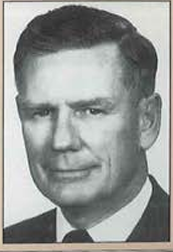
General Hamilton H. Howze, chairman of the Tactical Mobility Requirements Board or Howze Board, brought the Army forward towards acceptance of the Airmobility concept.
1957, General Hamilton H. Howze, then director of Army Aviation, in concert with Colonel Claude Sheppard, attempted to sell the Sky Cavalry idea, as put forth by Brigadier General Carl Hutton, General James M. Gavin and other practitioners of Airmobility, in order to impress upon military and civilian planners at the Pentagon, the benefits of Airmobility as a counter to the Soviet preponderance in tank armies in Eastern Europe arrayed against N.A.T.O. forces.
The Sky Cavalry response to Soviet armored thrusts was based upon the Russian dependence upon earth-bound infrastructure as opposed to the Sky Cavalry units which were saddled with no such impediments. The freedom of movement as enjoyed by Airmobile units, with moving troops, artillery, engineers, in concert with Close Air Support, including rotary wing tank busters. The mobility inherent in such formations could strike Soviet spearheads, control bridges and chokepoints during an advance or withdrawal, or act in support of friendly armored thrusts. Of course, a major drawback here was that anti-tank rotary wing type aircraft were not yet available.[13]
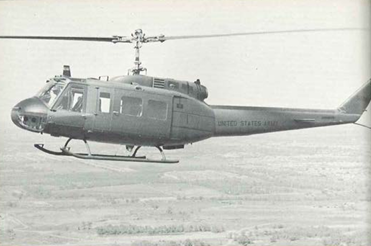
The Huey helicopter will be the steed for the Sky Cavalry concept in Vietnam. Indeed, the UH-1 will come to be a poster child expression of America during the Vietnam War.
This leads, of course, to a curious reality developing within that interim period between the Rogers and Howze Boards: That being that as the Army proceeded with such an agenda it was only going to inflame long-held Air Force concerns as to a rival air force controlled by the Ground Forces; while at the same time, the requirements of the foot sloggers was growing ever more pressing and sophisticated; thereby, creating that resolve to prevent that possibility of their aerial assets being reduced to the status of that of a trucking company; that a legitimate combat capability not only needed to be developed but to which the necessity for same was indeed urgent.[14]
Yet Army aviators had already been using helicopters to shuttle troops on an off the battlefield, such as with the beginnings of which in Korea. But now the combat environments seemed to be changing, from that of a conventional variety to that of counterinsurgency. “In fiscal year 1963 alone, Army helicopters flew 100,000 sorties and transported 275,000 South Vietnamese and 2,000 tons of cargo.”[15]
The political perception of Airmobility was evolving, and in favor of the Ground Forces. That to accomplish the mission of supporting the soldier on the ground, the Army “must move through the air to an ever increasing degree if it is to accomplish its mission . . . Army Aviation is clearly one of the essential elements of the Army’s overall capability. Air vehicles are bringing about a revolution in the Army’s ability to surmount the obstacles of time and terrain with the movement of troops, weapons and supplies . . . “Airmobility, which may well prove to be the decisive factor on any battlefield of the future, would be a paramount importance in coping with the effects of nuclear weapons should they be used.”[16] Such were the words of Secretary of the Army, Elvis J. Stahr.
On March 22, 1962, at an Association of the U.S. Army meeting, Secretary of Defense, Robert McNamara, was asked about the weight restrictions on Army aircraft, to which he stated that the Army would not be saddled with such handicaps, maintaining what he had stated earlier at a House Subcommittee on Defense Appropriations, when questioned about the 5,000 pound weight cap, “We are not applying any such limitations.”[17]
McNamara’s remarks forecast a significant change in the wind. The Rogers Board indicated a willingness to “update” the Army’s aerial assets for the realization fast materializing that aircraft were necessary for the shuttling of ground troops in the post-1945 era. But, little in the way of combat doctrine had even been broached, avoiding, perhaps, scratching the scab of that wound known as Roles and Missions, which would have led to that predictable Air Force reaction to what it views as a threat to its turf by the Army.
But the Rogers Board had been convened in the twilight of the Eisenhower Administration. McNamara represented the new guard, the Kennedy Administration. The New Look Defense strategy, with its accent on Massive Retaliation, was giving way to Flexible Response. The new President saw this vibrant superpower as able to protect its interests and prosecute the Cold War competition with Moscow with a more balanced approach to military doctrine. Where the New Look Defense favored atomic weaponry which favored the Air Force, followed by the Navy, conventional forces would see a resurgence, due to the former Massachusetts Senator’s proclivity towards counterinsurgency. Hence Vietnam. In other words, just as NSA ’47 was a Magna Carta for the Air Force, Flexible Response would be that Magna Carta for Army Aviation.
Endnotes
[1] See page 30, “The Air Close to the Trees: Evaluation and Innovation in U.S. Army Assault Helicopter Units During the Vietnam War,” by Adam Thomas Givens.
[2] See page 102, “Fire for Effect: Field Artillery and Close Air Support in the U.S. Army,” by John D. McGrath.
[3] A following global conflict will occur during the Technology Revolution, into which modern civilization finds itself for the foreseeable future.
[4] See page 92, John D. McGrath.
[5] See page 23, “Anything But: Joint Air-Ground Training at the U.S. Army Ground Combat Training Centers,” by Lieutenant Colonel Phillip B. Barks.
[6] See page 4, “Conceptual Underpinnings of the Air Assault Concept: The Hogaboom, Rogers and Howze Boards,” by Mark Olinger.
[7] See page 4, Mark Olinger.
[8] See page 5, Mark Olinger.
[9] See page 4, Chapter 1, “The Growth of the Airmobile Concept,” Vietnam Studies: Airmobility 1961-1971, by General John J. Tolson.
[10] Aircraft being replaced every ten years, for all intents and purposes, has proven to be a hollow projection. For instance, the CH-47 Chinook, which first flew in 1961, went into production 1962, as the replacement for such machines as the piston-engine CH-21, has been in service for more than sixty years.
[11] See page 5, Mark Olinger.
[12] General Howze himself states in his book, A Cavalryman’s Story, “The Howze Board,” page 235, “Because of its limited charter, the Rogers Board rejected, properly I suppose, my endeavor to insert into the basic report a few pungent thoughts about air fighting units, tactics and doctrine. I was allowed only to add a short addendum marked, ‘Enclosure I to Section VII,’ called ‘The Requirements for Air Fighting Units.’ I quote from it: I invite the special attention of the board to another area of aircraft tactical employment, hitherto unexploited, which is of fundamental importance to the army.
“MOMAR (Modern Mechanized Army, CONARC plan) and DCSOPS Plans I, II, III and IV are all devoted to the purpose of enhancing the combat capability of infantry, tank and reconnaissance units through the device of assigning those units additional quantities of light aircraft.
“Substantial benefits will undoubtedly accrue from this, but it should be fully acknowledged that the assigned and attached aircraft will simply improve the ability of these units to execute their conventional missions, and that the employment of aircraft will be restricted to those missions. A prime example exists in the armored cavalry regiments visualized in MOMAR and Plans I-IV: aerial reconnaissance companies will be very useful here, but the mission of the regiment, which has basically only wheeled mobility, will control and limit employment of the aircraft. In the days when the horse provided the highest degree of battlefield mobility, it would have been a fundamental error to restrict the assignment of horses to infantry divisions. While infantry divisions employed in considerable quantities, with benefit, it was necessary and desirable to group a substantial percentage of all the horses in cavalry units in order to take proper advantage of their mobility.
“I, therefore, submit that a new course of action, parallel to and of equal importance to the modernization of conventional type ground units, is urgently necessary. The Army should proceed vigorously and at once in the development of fighting units (which may be called air cavalry) whose mode of tactical employment will take maximum advantage of the unique mobility and flexibility of light aircraft—aircraft which will be employed to provide, for the execution of missions these units, not only mobility for the relatively few riflemen and machine gunners, but also direct fire support, artillery and missile fire adjustment, command, communications, reconnaissance and supply.
“Missions appropriate for assignment to air cavalry units are these: the seizure of critical terrain in advance of large forces, delaying action and cover for the withdrawal of larger forces, raids, penetration of shallow enemy positions and the disruption of enemy road areas, pursuit and exploitation, the protection of a long flank and wide reconnaissance. New weapons developments will provide air cavalry units with very destructive firepower, and these forces will develop many targets for the employment of surface-to-surface missiles. Air cavalry would find particular applicability in any battle area in which the threat of area weapons forces wide troop dispersion—and hence, a porous battlefield—as well as in ‘brush fire’ actions against relatively unsophisticated opponents.” See pages 235 and 236, “The Howze Board,” A Cavalryman’s Story, by Hamilton H. Howze.
[13] See page 98, A History of Army Aviation, by Dr. John Williams.
[14] See page 38, “Army Aviation 1970,” Army Aviation, January 1962, by Lieutenant Colonel Morris G. Rawlings.
[15] See page 18, “The Army and the Transformation, 1945-1991: Implications for Today,” by Lieutenant Colonel Arthur W. Conner, Jr., U.S. Army.
[16] See page 166, “Army Flying is not an end in Itself,” Army Aviation, April 1962, by Elvis J. Stahr.
[17] See page 23, “The Weight Limitation—May it Rest in Peace,” Army Aviation, by Brigadier General Delk M. Oden, May 1962.
Bibliography
Barks, Lieutenant Colonel Phillip B., U.S.A.F., Anything But: Joint Air-Ground Training at the U.S. Army Ground Combat Training Centers, Joint Advanced Warfighting School, Norfolk, Virginia, April 3, 2009.
Conner, Lieutenant Colonel Arthur E., Jr., U.S. Army, The Army and the Transformation, 1945-1991: Implications for Today, U.S. Army War College, Carlisle Barracks, Pennsylvania, April 9, 2002.
Givens, Adam Thomas, “The Air Close to the Trees: Evolution and Innovation in U.S. Army Assault Helicopter Units during the Vietnam War,” Wright State University, June 2, 2011.
Howze, Hamiton H., A Cavalryman’s Story, Smithsonian Institution Press, Washington and London, 1996.
McGrath, John J., Fire for Effect: Field Artillery and Close Air Support in the U.S. Army, Combat Studies Institute, U.S. Army Combined Arms Center, Fort Leavenworth, Kansas, 2010.
Oden, Brigadier General Delk M., Director of Army Aviation, ODCSOPS, “Weight Limitation—May it Rest in Peace,” Vol. 11, No. 5, Army Aviation, Westport, Ct., May 1962.
Olinger, Mark, “Conceptual Underpinnings of the Air Assault Concept: The Hogaboom, Rogers and Howze Boards,” The Land Warfare Papers, No. 60W, the Institute of Land Warfare, Association of the United States Army, Arlington, Virginia, December 2006.
Rawlings, Lieutenant Colonel, “Army Aviation 1970,” Vol. 11, No. 1, Army Aviation, Westport, Ct., January 1962.
Rawlins, Lieutenant Colonel Eugene W., U.S.M.C. and Sambito, Major William J., U.S.M.C., Marines and Helicopters, 1946-1962, Department of the Navy, History and Museums Division Headquarters, U.S. Marine Corps, Washington, D.C., 1976.
Stahr, Elvis J., Secretary of the Army, “Army Flying is not an end in itself,” Vol. 11, No. 4, Army Aviation, Westport, Ct., April 1962.
Tolson, Lieutenant General John J., Vietnam Studies: Airmobility, 1961-1971, Department of the Army, Superintendent of Documents, U.S. Government Printing Office, Washington, D.C., 1989. First printed 1973, CMH Pub 90-4.
Williams, Dr. James W., A History of Army Aviation: From its Beginnings to the War on Terror, iUniverse, Inc., Lincoln, Nebraska, 2005.










